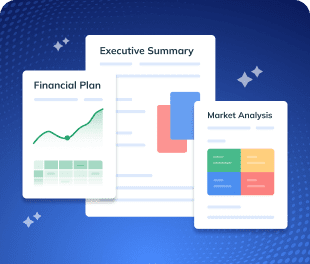Starting a box truck business can be a great way to tap into the growing demand for last-mile delivery, moving, and logistics services.
But to run it successfully, you’ll need more than just a truck—you’ll need a solid business plan that defines your goals, services, ideal clients, and how you’ll stay profitable.
Wondering how to create one? No worries!
This box truck business plan template will walk you through each step of writing a detailed business plan, from outlining your services to crunching the financial numbers in a simple, practical way.
Key components of a box truck business plan
Here are the 9 key components of a box truck business plan and what to include in each. We’ll break down each section step by step.
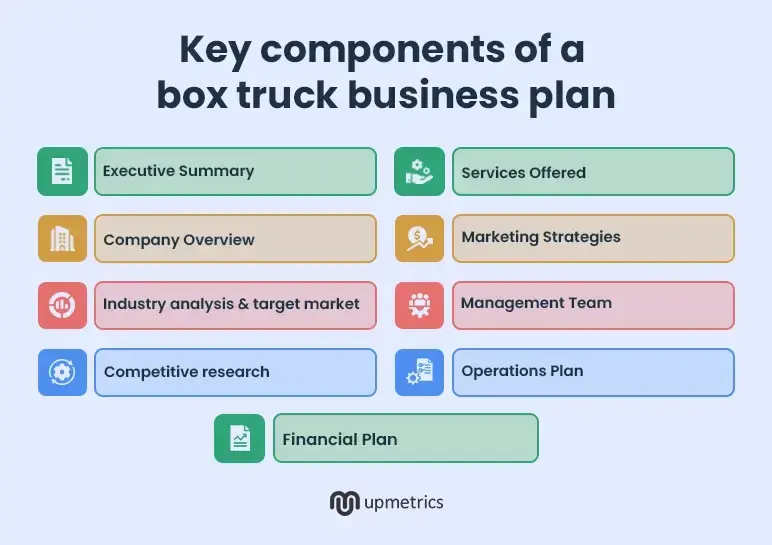
1. Executive Summary
The executive summary is a short and snappy overview of your entire business plan. Even though it appears at the front, you typically write this section last (after you’ve finalized all other sections).
In a few paragraphs, summarize the most important points about your box truck business, including:
- Basics: Your business name, location, and legal structure
- Business idea: What services do you offer, and what market do you need to fill?
- Target market: Who are your customers? Local businesses, e-commerce companies, or individuals needing moving services?
- Business goals: What do you aim to achieve (such as expanding a fleet or reaching a certain revenue target)?
- Financial outlook: Highlight expected profitability or funding needs (if any).
Keep the tone of the executive summary confident and clear. It should grab the reader’s interest and cover the basics of your plan at a glance.
Remember, some readers (like potential investors) may only read this section, so make it count.
Say goodbye to boring templates
Build your business plan faster and easier with AI
Plans starting from $14/month

2. Company Overview
Next, provide an informative overview of your box trucking company. This section gives readers an understanding of your box truck business’s identity and background.
The following are the key elements you need to include in your business description:
- Your business name and location
- Legal structure (a sole proprietorship or limited liability company)
- Mission and vision statements
- Company history and current status
- Milestones achieved so far
- Ownership structure
By the end of the company overview, the reader should have a clear picture of what your business is and why it exists.
Hence, keep it simple yet enthusiastic as you have to convey the strengths of your company and what makes it stand out (e.g., your unique experience, or a prime location that gives you an edge).
3. Industry analysis and target market
In this section, zoom out and describe the market environment for your box truck business. You need to show that you understand the industry you’re entering and the customers you plan to serve.
Start by describing the trucking/delivery industry relevant to your business. You might note that the demand for local delivery services has been growing due to the boom in online shopping and last-mile distribution.
Next, discuss the size or growth trend of the market if you have facts. For instance, the volume of local freight or the rise of same-day delivery expectations.
Are there any noteworthy trends?
Perhaps businesses are outsourcing deliveries instead of maintaining their own trucks, which could be an opportunity for you.
Besides that, understand your target market better. Who exactly are your ideal customers? Describe your primary customer segments.
For a box truck venture, this could include:
- Local retailers or wholesalers that need to transport goods to customers or between locations.
- E-commerce businesses or courier companies that need last-mile delivery help.
- Individuals or small offices relocating locally that might hire a box truck and driver for moving furniture and boxes.
- Event or catering companies that need equipment, supplies, or large items delivered to event venues regularly.
Furthermore, highlight the needs of each segment and why they would hire your service. If you plan to focus on a particular niche (say, strictly B2B deliveries for retailers), emphasize that.
Understanding your customers helps adjust the rest of your plan, from marketing to operations.
Here, you can add a detailed customer persona to give a good sense of your target customers’ demographic and psychographic details. For instance:
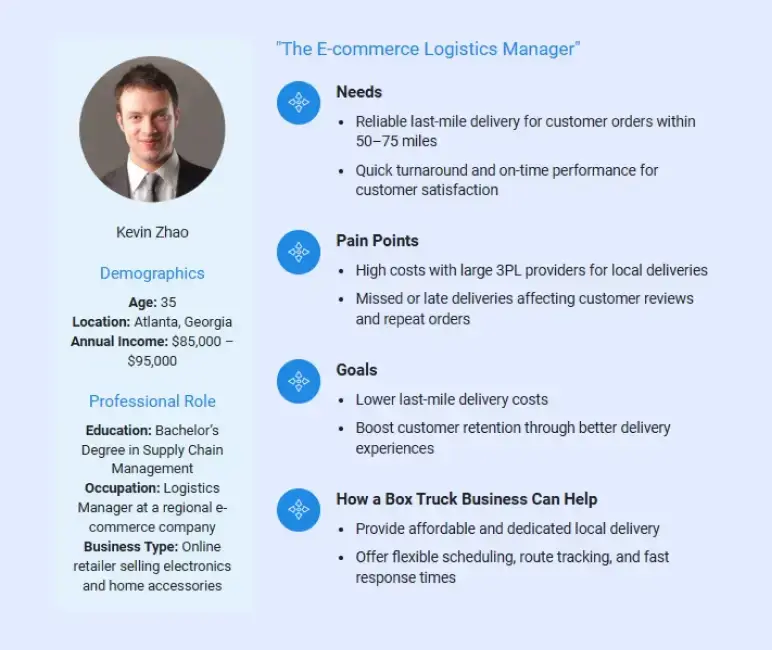
Also, mention any important industry regulations. Note if businesses like yours require special licenses or must comply with certain safety standards or weight limits for box trucks.
Research is key for this section. While detailed stats are nice, even a qualitative sense of the market is helpful for a beginner-level plan. Show that you’ve done your homework on who will use your box truck services and why they need them.
4. Competitive research
Every business faces competition, so your plan should identify who you’re up against and how you’ll stand out.
In the competitive analysis section, outline the other players in the market and what makes your box truck business different.
First of all, list your main competitors. These could be: Other independent box truck operators or small fleets, moving companies or van rental services, as well as large logistics companies.
For each direct competitor, shed light on what they do well and where there might be gaps.
Maybe a local rival has been around for years and has loyal clients (strength), but perhaps they have older trucks or less flexible scheduling (a potential weakness you can exploit).
Or perhaps the moving companies are expensive for small jobs, which means you can compete on price for that segment.
After surveying the competitive landscape, clearly explain how you’ll stand out and what your competitive advantage is. What will you do differently or better?
5. Service Offerings
Now, get specific about what services you’ll provide with your box truck or fleet of box trucks. This section is all about defining your product or service from the customer’s perspective.
As a box truck business owner, discuss what types of delivery or transportation services you offer. List each major service and give a brief description. For example:
| Service | Description |
|---|---|
| Local Delivery Contracts | Scheduled deliveries for retailers and wholesalers with a focus on reliability and speed. |
| Residential and Office Moving | Local moving services for apartments and small offices, including optional packing assistance. |
| Last-Mile Delivery for E-commerce | Final-leg delivery from distribution hubs to homes and businesses for online retailers. |
| Event and Equipment Transportation | Transporting equipment and supplies for events, caterers, and businesses on demand. |
| General Freight Hauling | Short-haul transport of small, urgent loads arranged through brokers or load boards. |
For each service, clarify how it generates revenue. For example, will you charge per mile, per hour, or a flat fee per delivery or per moving job? Also, highlight any important service policies.
Overall, this section paints a picture of how your business will actually make money. It also assures the reader that you have multiple streams of revenue.
Make sure the services align with the needs of your target market described earlier. If you’ve identified a big demand for furniture delivery, your services should address that directly.
6. Marketing Strategies
Having great services is important! But you also need customers to know about them.
The marketing strategies section explains how you’ll attract and retain clients for your box truck business. In other words, how will you get the word out and convince people to hire you instead of someone else?
To plan this section effectively, outline your approach to marketing and sales. Here are some strategies particularly relevant for a box truck business:
- Local online presence through a website or Google My Business
- Social media platforms (Facebook or Instagram) and online ads
- Networking and partnerships with local business associations
- Vehicle branding via business name, logo, and contact info painted on your truck
- Promotions, introductory offers, or loyalty programs
- Word of mouth marketing
By covering these tactics, you show that you have a plan to get customers in the door. You might not implement all strategies at once, but demonstrate you know where to start.
The key is to convince the reader that you won’t be sitting idle, hoping customers magically find you. Instead, you have concrete ideas to promote your box truck services and generate revenue.
7. Management Team
Investors and lenders often say they invest in people as much as in ideas. And as the name itself indicates, the management team section is all about who is running the show and why they’re capable of making the business succeed.
Even if you’re a one-person operation to start, you should provide a clear picture of the management and leadership of your box truck business.
As a box truck owner, start with yourself (if that’s you only). Provide a brief background—mention relevant experience, skills, or qualifications. Note if you have a trucking background, logistics or managerial experience, or even just a passion and knowledge of the industry.
If you have a small team, introduce the key team members and their roles. For instance: Dispatch/Operations Coordinator, Drivers, Mechanic, or Maintenance Partner.
Give a brief description (a few sentences at most), focusing on what they bring to the table. Emphasize relevant experience: driving certifications, business management, logistics planning, customer service, etc.
For a small business, you could include a simple organizational chart to visualize your team structure and how responsibilities are divided. Something like this:
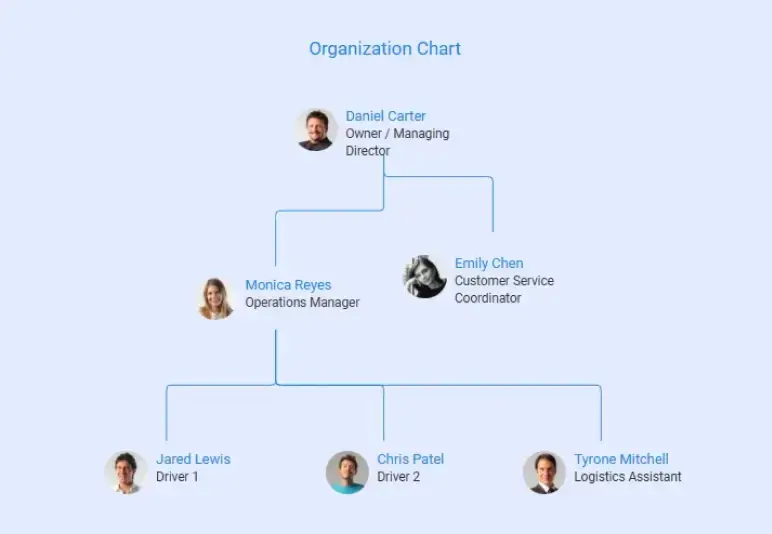
Furthermore, mention advisors or mentors if you have guidance from someone experienced. While not part of daily operations, an advisor’s insight can add credibility.
If you plan to have additional staff (now or in the future), mention the roles you’ll fill. This shows you have a plan for delegation and team growth when the time comes.
8. Operations Plan
The operations plan section explains the day-to-day workflow and logistics of running your box truck company.
Think of it as a behind-the-scenes tour of how you’ll deliver your services. You want to convince the reader that you have a handle on the practical aspects of the business.
Here are the key operational aspects to cover:
Service Process (Workflow)
Describe how a job moves from start to finish in your business. If you have multiple services, outline the process for each briefly (e.g., moving service might involve an on-site estimate, then scheduling a moving day, etc.).
This shows you understand what needs to happen step-by-step to fulfill orders efficiently.
Operating Hours and Area
State your business hours and any limits on where you’ll go. If you’re open to longer hauls or 24/7 emergency jobs, mention that too. Setting these expectations helps in planning driver schedules and customer expectations.
Logistics and Suppliers
Note how you’ll handle the logistics of fueling and supplies.
- Will you fuel up at specific stations with fleet discounts?
- Do you have a secure parking location for the truck when not in use?
- How will you schedule jobs to maximize truck usage without overbooking?
If your operations require consumables (like moving blankets, packing materials, etc.), mention where you’ll get those.
Equipment and Maintenance
Detail what equipment you have and how you’ll keep it running. List your truck(s). If you have any additional equipment (hand trucks, dollies, straps, GPS devices), note those since they are important for operations.
Crucially, explain your maintenance plan: regular oil changes, tire checks, etc., and who will do them.
Quality Control and Customer Service
Explain how you’ll maintain a high service quality. Mention any customer service practices:
- Do you follow up with clients for feedback?
- Do you handle claims for damage promptly?
This highlights your commitment to continuous improvement.
Tools and Systems
Identify any software or systems you’ll use to streamline operations. Many small transport businesses use tools like routing software or apps, dispatch management software, or even just well-organized spreadsheets.
If you plan to use GPS tracking or an app for customers to sign deliveries electronically, include that.
In short, the operations plan demonstrates that you’ve figured out the nuts and bolts of how to deliver your service reliably and efficiently. It connects the high-level idea of your business to the real-world execution. So, focus on keeping explanations practical and straightforward.
9. Financial Plan
Now, numbers time! The financial plan is where you outline the financial projections and realities of your box truck business.
This section is critical if you’re seeking funding, but even if not, it helps you ensure the business can be profitable. You don’t need to be an accountant to create a basic financial plan. You just need to think through your expected revenues and costs.
The following are the essential financial statements and projections you must include in your plan:
- Startup costs needed to launch
- Ongoing monthly or yearly expenses
- Revenue estimates (how much you will earn)
- Income statement (profit & loss statement)
- Cash flow statement
- Balance sheet (assets, liabilities, and equity)
- Break-even analysis
If you’re writing this plan to secure funding (loan or investment), clearly state how much you need and for what purpose. For example:
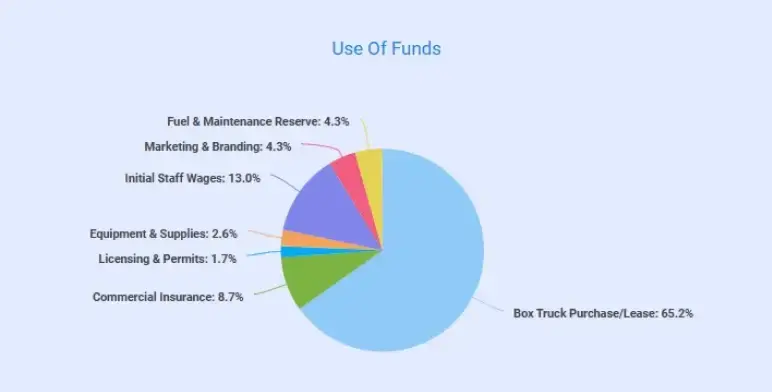
| Expense Category | Estimated Cost (USD) | Purpose |
|---|---|---|
| Box Truck Purchase/Lease | $75,000 | Purchase or lease of commercial box truck(s). |
| Commercial Insurance | $10,000 | Insurance coverage for vehicle, cargo, and liability. |
| Licensing & Permits | $2,000 | DOT registration, business licenses, and local operating permits. |
| Equipment & Supplies | $3,000 | Moving tools, safety gear, GPS, straps, and protective materials. |
| Initial Staff Wages | $15,000 | Payroll for drivers and helpers during initial launch phase. |
| Marketing & Branding | $5,000 | Website, truck decals, online/local advertising, and marketing materials. |
| Fuel & Maintenance Reserve | $5,000 | Initial operating expenses for fuel and routine truck maintenance. |
| Total | $115,000 | Total startup capital required. |
It’s wise to mention the key assumptions behind your projections. This helps readers understand how you arrived at your numbers and gives them confidence that you’re not just guessing wildly. It also prepares you to adjust the plan if some assumptions change.
Lastly, ensure the reader (investors or lenders) feels confident that your box truck business can be profitable and financially sustainable. Hence, keep it realistic and based on research, if you’re not sure about typical costs or rates.
Benefits of writing a box truck business plan
A box truck business plan isn’t just a document; it’s a crucial tool to drive your business in the right direction. Whether you’re seeking financing or just want a structured growth strategy, writing a plan brings many benefits:
- Forces you to define your ideas as well as goals, and directs you to reach them.
- Attracts lenders or partners by showing you understand the market and have a strategy to make money.
- Helps you stay compliant and avoid costly fines or shutdowns due to oversight.
- Encourages you to anticipate challenges and think of solutions on how to navigate them in advance.
Simply put, a solid business plan sets a strong foundation for your box truck venture while keeping you organized, focused, and proactive!
Download a free box truck business plan template
Writing a business plan from scratch can feel overwhelming, especially if it’s your first time. The good news is you don’t have to start with a blank page. Download our free box truck business plan template to get started.
This template will have all the essential sections we discussed, along with prompts and examples, so you know what information to fill in. You can even customize the template to fit your unique ideas and strategies, saving you time formatting.
The Quickest Way to turn a Business Idea into a Business Plan
Fill-in-the-blanks and automatic financials make it easy.
Conclusion
By now, you’ve seen how each section of the plan helps you think through a different angle of your business, from the high-level mission down to the daily operations and dollars and cents.
So, it’s much easier for you to organize your thoughts and draft a comprehensive box trucking business plan without skipping any critical parts.
However, if you’re still confused about details or seeking an easy way to create a plan, Upmetrics could be your go-to solution. It helps you streamline the planning process and speed up writing with its advanced AI capabilities and financial forecasting features.
So, why wait? Start planning now!
